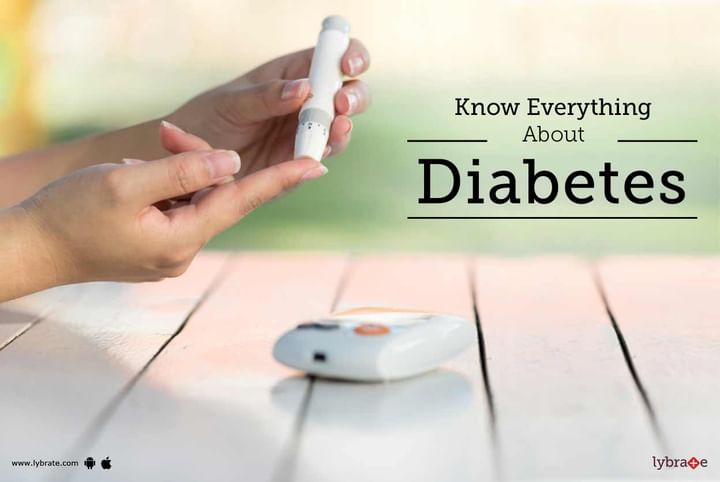Know Everything About Diabetes
Diabetes is one of the most common problems that are caused by obesity, unhealthy and inactive lifestyle. It is a metabolic disorder in which the body is unable to store and use energy from food. Being physically inactive and eating unhealthy food are primary causes of diabetes. It is a long term condition, which causes high or unstable blood sugar levels in the body.
When a patient suffers from low blood sugar it is called Hypoglycemia and if the blood sugar levels are too high, it is called Hyperglycemia. Both are extremely harmful for a patient.
Type 1 and Type 2 and Gestational Diabetes:
Type 1
In Type 1 diabetes, the body does not produce insulin. The condition has no known cure and is usually hereditary in nature. Approximately 10% of those suffering from diabetes have Type 1 diabetes. Patients with Type 1 diabetes have to take regular medication, including insulin injections as well as take care of their diet.
Type 2
Type 2 diabetes happens when the body does not produce enough insulin for its proper functioning. 90% of all diabetic people suffer from Type 2 diabetes. It is usually caused by poor lifestyle choices, like physical inactivity and unhealthy food habits. The disease lasts a lifetime and is usually progressive in nature, but can be managed by taking regular medication, choosing an active lifestyle and maintaining proper body weight.
Gestational Diabetes
Diabetes during pregnancy is known as gestational diabetes. This has to be managed by taking medication or in extreme cases insulin shots. If undetected or untreated, gestational diabetes increases complications during childbirth, and causes unusual weight gain in the baby. However, gestational diabetes usually ends after the baby is born and women can go back to their normal lifestyle and eating habits post delivery.
Symptoms of Diabetes
- Frequent urination
- Extreme hunger or thirst
- Weight loss
- Problems with vision
- Tingling or numbness of the extremities.
- Unexplained fatigue
- Dry skin
- Cuts or sores that heal slowly
- High number of infections
Who is at greatest risk for developing diabetes?
People who:
- are 45 or over
- are overweight
- are habitually physically inactive
- have previously been identified as having IFG (impaired fasting glucose) or IGT (impaired glucose tolerance)
- have a family history of diabetes
- are members of certain ethnic groups (including Asian American, African American, Hispanic American, and Native American)
- have had gestational diabetes or have given birth to a child weighing more than 9 pounds
- have elevated blood pressure
- have an HDL cholesterol level (the good cholesterol) below 35 mg/dl and/or a triglyceride level above 250 mg/dl
- have polycystic ovary syndrome
- have a history of vascular disease
What is pre-diabetes?
Pre-diabetes is a condition of elevated blood glucose level that has not yet reached a diabetic level. Along with insulin resistance, pre-diabetes causes no symptoms. An individual may be pre-diabetic for years without knowing it. Pre-diabetes increases your risk of developing Type 2 diabetes and heart disease. Weight loss and exercise may halt the onset of diabetes from pre-diabetes by returning blood glucose levels to a normal range.
Complications of Diabetes
Long-term complications of diabetes develop gradually. The longer you have diabetes — and the less controlled your blood sugar — the higher the risk of complications. Eventually, diabetes complications may be disabling or even life-threatening. Possible complications include:
- Cardiovascular disease - If you have diabetes, you are more likely to have heart disease or stroke.
- Nerve damage (neuropathy) - Excess sugar can injure the walls of the tiny blood vessels (capillaries) that nourish your nerves, especially in your legs. This can cause tingling, numbness, burning or pain that usually begins at the tips of the toes or fingers and gradually spreads upward. Left untreated, you could lose all sense of feeling in the affected limbs.
- Kidney damage (nephropathy) - The kidneys contain millions of tiny blood vessel clusters (glomeruli) that filter waste from your blood. Diabetes can damage this delicate filtering system. Severe damage can lead to kidney failure or irreversible end-stage kidney disease, which may require dialysis or a kidney transplant.
- Eye damage (retinopathy) - Diabetes can damage the blood vessels of the retina (diabetic retinopathy), potentially leading to blindness. Diabetes also increases the risk of other serious vision conditions, such as cataracts and glaucoma.
- Foot damage - Nerve damage in the feet or poor blood flow to the feet increases the risk of various foot complications. Left untreated, cuts and blisters can develop serious infections, which often heal poorly.
- Skin conditions - Diabetes may leave you more susceptible to skin problems, including bacterial and fungal infections.
- Hearing impairment - Hearing problems are more common in people with diabetes. If you wish to discuss about any specific problem, you can consult an endocrinologist and ask a free question.



+1.svg)
